Editor of this issue: Violeta Kelertas
Copyright © 1999 LITUANUS Foundation, Inc.

|
LITUANUS
LITHUANIAN QUARTERLY JOURNAL OF ARTS AND SCIENCES
Volume 45, No. 3 - Fall 1999
Editor of this issue: Violeta Kelertas ISSN 0024-5089
Copyright © 1999 LITUANUS Foundation, Inc. |

|
RIMVIDAS JANKAUSKAS (KAMPAS)
RASA ANDRIUŠYTĖ
The period of creative activity of the artist was rather short - 1987 - 93, but it was extremely prolific. In a sense, his work can be treated as a direct opposite to contemporary Lithuanian painting or at least as an exceptional case. It is characterized by uttermost expressiveness, spontaneity and even brutality. The colors are extremely intense. The artist prefers large formats, he often expands and flattens his motifs or selects only a fragment for his composition. In general, Kampas' work conveys the impression of impetuosity, spontaneity and extreme vigor. He can be considered one of the bravest and freest Lithuanian artists: in art he demonstrated temperamental emotionality and open-mindedness, in life he spared neither physical nor spiritual resources and he destroyed himself by the use of alcohol, balancing every day between life and death. All this was the essence of his life, eventually leading to his death. He died in 1993, at the age of 35.
R. Jankauskas appearance' in Lithuanian art in 1987 appeared to be like a wild dissonance, an outburst and an antithesis to the then dominant conception of colorist, emotionally balanced painting. It is probable that the essence of his art was just this eruption and rebelliousness, caused by the suppression and spiritual oppression, which he and his generation had to experience. In the context of contemporary Lithuanian painting it is difficult to attribute Kampas' work to any single trend. Rather he himself constituted a trend, which later found its followers. However, that does not mean that it makes no sense to look for footholds of Kampas' painting in Lithuanian art. In his work complicated personal experiences are interwoven with expressionist assertiveness. Namely, this phenomenon is rather typical of the artists of the pre-war group "ARS" and of the older generation of painters - A. Martinaitis, J. Švažas, A. Vilpišauskas - whom Jankauskas considered his teachers. However, unlike the above-mentioned artists, Kampas refuses to produce space illusion in his pictures, and rejecting a constructive motif drawing, devotes himself to the magic of stroke and color. Color, its intensity and its psychological effect are of paramount importance for Kampas. Next to color, he paid particular attention to plastics. The patriarch of Lithuanian sculpture, Robertas Antinis, in whose workshop he worked at one time as a helper, instilled the primacy of form, one of the main principles in his art, in the young artist.
Although Kampas took pride in calling himself a formalist, his work is not merely solutions of formalist tasks, it is not abstract painting. The layer of meaning and subject is nearly always present in his works, but what is especially peculiar to his, it "drowns" in a whirl of forms and colors. Jankauskas managed to find an exact pictorial-plastic equivalent for themes, subjects, events and experiences, not only constituting a part of the world of his emotions and notions (namely, this feature is typical of many artists of the younger generation), but also having their basis either in real life or in the layers of literature, art or world mythology. Thus Kampas enlarged on the of ideas in Lithuanian painting. No matter how subjectively treated, the motif and subject were always important for the painter.
Jankauskas' familiarity with 20th century modern art was quite good. Post-impressionism, the group "Briicke" and the abstract expressionism of V. Kandinsky were his favorites. He learned improvisation and plasticity from the representatives of abstract expressionism and the world outlook of post-impressionists (Vincent van Gogh primarily) and of the artists of "Brücke" were close to him. The Lithuanian artists interpreted quite a few themes of van Gogh, E. Nolde and M. Beckman and all of them shared the same favorite motifs - black sun, apple-tree, footbridge, synagogue. Kampas interpreted the same subjects in his own way, treating them as paraphrases and as conversations with the authorities, who had influenced his style.
In the last period of his work, about the year 1980, Kampas produced quite a number of works, in which traces of direct following are quite evident. He made collages similar to those of K. Schwitters, in his still lives he used to reshape and enlarge form in the manner of "ARS". The subject of his early still lifes resemble the motifs of A. Samuolis - unassuming interiors, separate household objects, etc. Dark colors also attest to his interest in the expressionist manner of Lithuanian painting.
In 1987 Jankauskas graduated from the Art Academy of Vilnius under the guidance of Prof. V. Gečas. However, the years 1972 - 79, spent at the Stepas Žukas School of Applied Arts in Kaunas were more important for the formation of his character. Together with his schoolmates, now quite well known artists J. Gasiūnas, H. Čerapas and V. Dubauskas, he indulged in the hippie way of life. Nevertheless, he found time to study Lithuanian classical painting at the M. K. Čiurlionis Art Museum, to read the works of world literature and to paint. However, conflicts with the governing bodies of the School and later of the Art Academy were unavoidable because of his "asocial lifestyle". Graduation from the Academy, his diploma project, was the last compromise in his work. In the diploma project realism was obligatory, nevertheless, Kampas managed to expose the rhythmic and architectonic features of his subject - a combine harvester, selecting bright yellow colors. The plasticity of the picture contain clues to further creative intentions of the young artist.
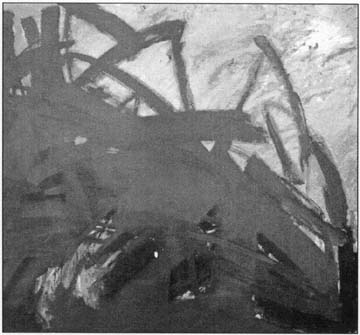
Goodbye Synagogue, 1991, oil, 210x228
In his first solo show in Kaunas in 1989, Kampas exhibited works, stunning the viewer by their freedom and independence from any local authorities. His drastic, sometimes conflicting attitude to the phenomena of life, penetrates through his exceptionally emotional and vital brushwork. In his canvases Kampas accentuates the conflicting nature of the world: his landmark pictures - "All Beasts", "All Other Beasts", 1989 - contain motifs not only of human faces, masks of animals, but also pacifist symbols. Wide range, large formats, subjects, unusual for Lithuanian painting is striking in Kampas' pictures.
Free improvisation, greater attention to instinctive impulses have come into prominence in R. Jankauskas work since 1990. Some of the pictures of this period are called by the artist (following V. Kandinsky) "improvises", expressing and reflecting his "internal nature". Free, improvisational brushwork, emphatic attention to wavy, broken lines and to the generalized color patch are peculiar to Kampas' nudes and portraits. Actually they turn into abstract improvisations on the themes of the female body, portrait, self-portrait, music and dance. "Double Portrait", 1989, "Triplet", 1991, "Nude", 1990, are the most specific specimens of this abstract trend.
In 1991 - 92 Jankauskas often painted in plain air, he loved the nature of Western Lithuania - Ventės Ragas and the Couronian Spit. In- small-format compositions of nature motifs he boldly experimented with color and texture. The same motifs - water, bog, footbridge, sunset, dune - were often repeated. The landscapes differ from the rest of his work by their solemn and concentrated mood. These sketches are very similar to the abstractions of Pierre Soulage, N. de Stael and F. Kline of the '50s. At the same time very peculiar features of "calligraphic expressionism" begin to develop. In his 1989 - 90 compositions and abstractions there is still much simple automatism and a sketchy form is produced by rather mechanical strokes, whereas around 1991 - 92 the painter begins to attach greater significance and aestheticism to brush calligraphy. But even now Kampas is not a pure abstract expressionist. Calligraphy, rhythm and architectonics of the pictures ("Storm Cloud", 1992, "Good-bye, Synagogue", 1991) are of utmost importance, but they are inspired by a nature motif. Everything is a result of the moods of "internal necessity".
Notwithstanding the greatest attention paid by the artist to the formal aspects of painting, his works always have a real image equivalent, be it a particular person, an object or a nature motif. The painter has never approached the limit of absolute abstraction.
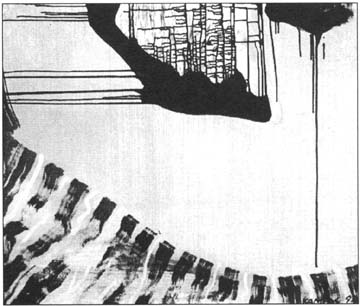
Woman with a Red Stocking, 1992, oil, 85x100
About 1992 a new tendency develops in Jankauskas' work - a literary subject becomes frequent, fantastic or romantic subjects of the history of culture, as in "Headless Horseman", "Return of the Son Triton", or paraphrases of the history of Ancient Egypt. At this time Kampas produces rather abstract and subjectively coded allegories, abounding in drastic and tragic elements. The manner of painting and technique change too. "Non-pictorial painting" appears, when soft strokes create a more spacious form and color turns into dimensionality. The return to a clearly expressed theme and at the same time to the "traditional easel picture" can be accounted for by the artist's trip to Germany, where he had a chance to get acquainted with recent trends in European art. Among other things, the artist was greatly impressed by the neo-expressionist painting of the German "Neue Wilde" with their chaotic and rough brushwork, color intensity and large formats, i.e., the features, which Kampas had been intuitively developing during his last years.
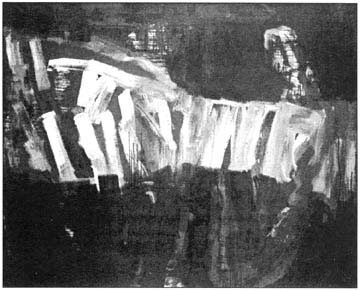
Return of the Son Triton, 1993, oil, 190x149.5
In the last year of his life (1993) tragic traits appeared in his work. The comparison of his pictures on the theme of the synagogue shows that "Good-bye Synagogue" (1991) is painted as an emotional impulse, based on color and symbolism, while "Desolate Synagogue" (1993) is characterized by a real tangible motif and perspective composition. The latter picture is not the mere expression of personal experience, it is an expressive epic narrative. Canvases with the synagogue motif possibly are the maturest works of the artists. But returning again to the subject and motif, the painter does not separate the temperamental expressive gesture and intense color combinations. However, all this manifested itself in a series of extremely bright, burning "advertising" colors and in a slightly fragmented avalanche of strokes; while in the mature works of 1993, in which the form is more disciplined and concrete, expressiveness becomes a feature of the fluidity of the picture. Kampas makes the composition pure, concentrates his attention on one simple motif and his art language becomes laconic and exact. At his solo exhibition in the Picture Gallery of Kaunas in 1993 the painter said he had finished one stage of his work.
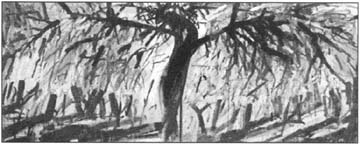
Crucified Apple Tree, 1993, oil, 150x380
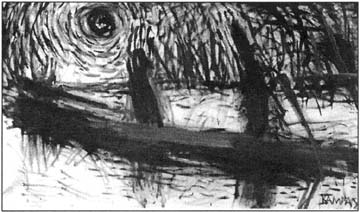
Black Sun, 1993, oil, 100x172.5
Rimvidas Jankauskas (Kampas) was an extraordinary personality, he introduced a free, brave and unrestricted gesture into Lithuanian painting. He considered painting the most important action in life, the essence of his life. Kampas' work is also meaningful in that it expressed openly and exactly the world outlook of the artists of his generation, of the town children, the hippie followers of the '60s. In his painting it is easy to see a peculiar 20th century projection of modernist ideas of art, music and literature.